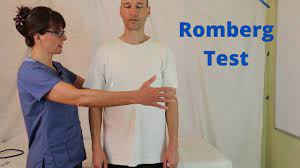 1070
1070
Romberg’s test, Romberg’s sign, or the Romberg maneuver is a test used in an exam of neurological function for balance.
It is a test for driving under the influence of an intoxicant.
One requires at least two of the three following senses to maintain balance while standing:
proprioception, which is the ability to know one’s body position in space.
vestibular function referring to the ability to know one’s head position in space.
vision used to monitor and adjust for changes in body position.
It is an exam of neurological function for balance.
A patient who has a problem with proprioception can still maintain balance by using vestibular function and vision.
In the Romberg test, the standing patient is asked to close his or her eyes.
A positive Romberg’s test indicates an increased loss of balance.
It tests the body’s sense of proprioception, which requires healthy functioning of the dorsal columns of the spinal cord.
It is used to investigate the cause of loss of motor coordination.
A positive Romberg test suggests that the ataxia is sensory in nature, that is, depending on loss of proprioception.
It is a sign of myelopathy with posterior column involvement.
It is viewed as evidence of visual dependence indicating functionally significant loss of proprioceptive or peripheral vestibular function.
If a patient is ataxic and Romberg’s test is not positive, it suggests that ataxia is cerebellar in nature, that is, depending on localized cerebellar dysfunction..
It is used as an indicator for possible alcohol or drug impaired driving.
The test is performed with the subject estimating 30 seconds in their head, using the time to gauge the subject’s internal clock and can be an indicator of stimulant or depressant use.
During the test the patients stands erect with feet together and eyes closed.
The movement of the body in relation to a perpendicular object is observed, and a positive sign is noted when a swaying, sometimes irregular swaying and even toppling occurs.
The patient becomes more unsteady with eyes closed.
The test:
the subject stands with feet together, eyes open and hands by the sides.
the subject closes the eyes while the examiner observes for a full minute.
Romberg’s test is positive if the patient falls while the eyes are closed.
Swaying is not a positive sign as it shows proprioceptive correction.
The test is indicative but balance comes from the combination of several neurological systems, namely proprioception, vestibular input, and vision.
When two of these systems are working one should be able to demonstrate a fair degree of balance.
When vision is taken away by asking the patient to close their eyes, it leaves only two of the three systems, and if there is a vestibular disorder or proprioceptive dysfunction there is much more unbalance.
To be able to maintain balance while standing in the stationary position relies on intact sensory pathways, sensorimotor integration centers and motor pathways.
The main sensory inputs for balance are:
Position sense (proprioception), carried in the dorsal columns of the spinal cord, the dorsal and ventral spinocerebellar tracts.
Vision
Vestibular apparatus
The brain can obtain sensory sufficient information to maintain balance if any two of the three systems are intact.
Sensorimotor integration is carried out by the cerebellum and by the dorsal column-medial lemniscus tract.
The motor pathway is the corticospinal tract and the medial and lateral vestibular tracts.
A variation of the Romberg Test, the Sharpened Romberg Test, consists of narrowing the patient’s base of support by placing feet in a heel to toe position.
Romberg’s test is positive in conditions causing sensory ataxia such as:
Vitamin deficiencies such as Vitamin B12
Conditions affecting the dorsal columns of the spinal cord, such as neurosyphilis.
Conditions affecting the sensory nerves such as chronic inflammatory demyelinating polyradiculoneuropathy
Friedreich’s ataxia
Ménière’s disease
A positive Romberg’s test which will show wide base gait in patients with back pain has been shown to be 90 percent specific for lumbar spinal stenosis.
It is not a test of cerebellar function, as patients with cerebellar ataxia will, generally, be unable to balance even with the eyes open.
No patient with cerebellar ataxia can correctly be described as Romberg’s positive.
The Romberg’s test is a test of the proprioception receptors and pathways function.
